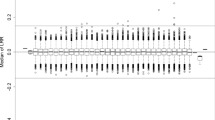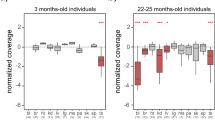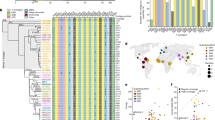Abstract
Human ‘XX males’ are sterile males whose chromosomes seem to be those of a normal female. About 1 in 20,000 males has a 46, XX karyotype, and most cases are sporadic, that is, they are without familial clustering1. It has long been argued that maleness in XX males may result from the undetected presence of a small, testis-determining fragment of the Y chromosome2, and there is strong evidence for this in sporadically occurring XX males3–5. Indeed, the genomes of three of four sporadic XX males tested were found to contain certain Y-specific DNA sequences6. A pedigree in which three XX males occur has been interpreted as being consistent with autosomal recessive inheritance of maleness7,8, and it has been argued that the basis of XX maleness in this family is fundamentally different from that in the sporadic cases9. However, we report here that these related XX males, like the sporadic cases, contain portions of the Y chromosome. The portion of the Y chromosome present in one of the three XX males differs from that present in the other two.
This is a preview of subscription content, access via your institution
Access options
Subscribe to this journal
Receive 51 print issues and online access
$199.00 per year
only $3.90 per issue
Buy this article
- Purchase on Springer Link
- Instant access to full article PDF
Prices may be subject to local taxes which are calculated during checkout
Similar content being viewed by others
References
de la Chapelle, A. Hum. Genet. 58, 105–116 (1981).
Ferguson-Smith, M. A. Lancet ii, 475–476 (1966).
Evans, H. J., Buckton, K. E., Spowart, G. & Carothers, A. D. Hum. Genet. 49, 11–31 (1979).
Magenis, R. E. et al. Hum. Genet. 62, 271–276 (1982).
de la Chapelle, A., Tippett, P. A., Wetterstrand, G. & Page, D. Nature 307, 170–171 (1984).
Guellaen, G. et al. Nature 307, 172–173 (1984).
de la Chapelle, A., Schröder, J., Murros, J. & Tallqvist, G. Clin. Genet. 11, 91–106 (1977).
de la Chapelle, A., Koo, G. C. & Wachtel, S. S. Cell 15, 837–842 (1978).
Burgoyne, P. Nature 307, 109 (1984).
Kasdan, R. et al. New Engl. J. Med. 288, 539–545 (1973).
Minowada, S. et al. Clin. Genet. 15, 399–405 (1979).
Nicolis, G. L. et al. Am. J. Med. 52, 482–491 (1972).
Page, D. C. & de la Chapelle, A. Am. J. hum. Genet. 36, 565–575 (1984).
Southern, E. M. J. molec. Biol. 98, 503–517 (1975).
Singh, L. & Jones, K. W. Cell 28, 205–216 (1982).
Evans, E. P., Burtenshaw, M. D. & Cattanach, B. M. Nature 300, 443–445 (1982).
Eicher, E. M. in Prospects for Sexing Mammalian Sperm (eds Amann, R. P. & Seidel, G. E.) (Colorado Associated University Press, Boulder, 1982).
Berg, K. & Bearn, A. G. A. Rev. Genet. 2, 341–362 (1968).
Author information
Authors and Affiliations
Rights and permissions
About this article
Cite this article
Page, D., de la Chapelle, A. & Weissenbach, J. Chromosome Y-specific DNA in related human XX males. Nature 315, 224–226 (1985). https://doi.org/10.1038/315224a0
Received:
Accepted:
Published:
Issue Date:
DOI: https://doi.org/10.1038/315224a0
This article is cited by
-
SRY-negative true hermaphrodites and an XX male in two generations of the same family
Human Genetics (1996)
-
Die Genetik der menschlichen Geschlechtsdetermination und ihre St�rungen
Naturwissenschaften (1994)
-
The pseudoautosomal regions of the human sex chromosomes
Human Genetics (1993)
-
Molecular cytogenetic analysis of XX males using Y-specific DNA sequences, including SRY
Human Genetics (1992)
Comments
By submitting a comment you agree to abide by our Terms and Community Guidelines. If you find something abusive or that does not comply with our terms or guidelines please flag it as inappropriate.



